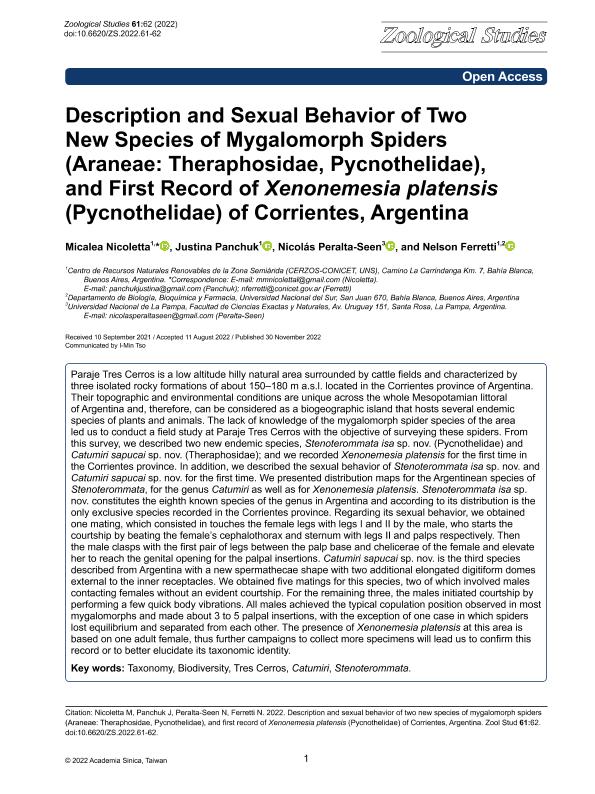Mostrar el registro sencillo del ítem
dc.contributor.author
Nicoletta, Micaela Mariel

dc.contributor.author
Panchuk, Justina

dc.contributor.author
Peralta Seen, Nicolás
dc.contributor.author
Ferretti, Nelson Edgardo

dc.date.available
2023-07-26T11:32:25Z
dc.date.issued
2022-12
dc.identifier.citation
Nicoletta, Micaela Mariel; Panchuk, Justina; Peralta Seen, Nicolás; Ferretti, Nelson Edgardo; Description and Sexual Behavior of Two New Species of Mygalomorph Spiders (Araneae: Theraphosidae, Pycnothelidae), and First Record of Xenonemesia platensis (Pycnothelidae) of Corrientes, Argentina; Academia Sinica; Zoological Studies; 61-62; 12-2022; 1-18
dc.identifier.issn
1021-5506
dc.identifier.uri
http://hdl.handle.net/11336/205519
dc.description.abstract
Paraje Tres Cerros is a low altitude hilly natural area surrounded by cattle fields and characterized by three isolated rocky formations of about 150–180 m a.s.l. located in the Corrientes province of Argentina. Their topographic and environmental conditions are unique across the whole Mesopotamian littoral of Argentina and, therefore, can be considered as a biogeographic island that hosts several endemic species of plants and animals. The lack of knowledge of the mygalomorph spider species of the area led us to conduct a field study at Paraje Tres Cerros with the objective of surveying these spiders. From this survey, we described two new endemic species, Stenoterommata isa sp. nov. (Pycnothelidae) and Catumiri sapucai sp. nov. (Theraphosidae); and we recorded Xenonemesia platensis for the first time in the Corrientes province. In addition, we described the sexual behavior of Stenoterommata isa sp. nov. and Catumiri sapucai sp. nov. for the first time. We presented distribution maps for the Argentinean species of Stenoterommata, for the genus Catumiri as well as for Xenonemesia platensis. Stenoterommata isa sp. nov. constitutes the eighth known species of the genus in Argentina and according to its distribution is the only exclusive species recorded in the Corrientes province. Regarding its sexual behavior, we obtained one mating, which consisted in touches the female legs with legs I and II by the male, who starts the courtship by beating the female’s cephalothorax and sternum with legs II and palps respectively. Then the male clasps with the first pair of legs between the palp base and chelicerae of the female and elevate her to reach the genital opening for the palpal insertions. Catumiri sapucai sp. nov. is the third species described from Argentina with a new spermathecae shape with two additional elongated digitiform domes external to the inner receptacles. We obtained five matings for this species, two of which involved males contacting females without an evident courtship. For the remaining three, the males initiated courtship by performing a few quick body vibrations. All males achieved the typical copulation position observed in most mygalomorphs and made about 3 to 5 palpal insertions, with the exception of one case in which spiders lost equilibrium and separated from each other. The presence of Xenonemesia platensis at this area is based on one adult female, thus further campaigns to collect more specimens will lead us to confirm this record or to better elucidate its taxonomic identity.
dc.format
application/pdf
dc.language.iso
eng
dc.publisher
Academia Sinica

dc.rights
info:eu-repo/semantics/openAccess
dc.rights.uri
https://creativecommons.org/licenses/by-nc-sa/2.5/ar/
dc.subject
BIODIVERSITY
dc.subject
CATUMIRI
dc.subject
STENOTEROMMATA
dc.subject
TAXONOMY
dc.subject
TRES CERROS
dc.subject.classification
Zoología, Ornitología, Entomología, Etología

dc.subject.classification
Ciencias Biológicas

dc.subject.classification
CIENCIAS NATURALES Y EXACTAS

dc.title
Description and Sexual Behavior of Two New Species of Mygalomorph Spiders (Araneae: Theraphosidae, Pycnothelidae), and First Record of Xenonemesia platensis (Pycnothelidae) of Corrientes, Argentina
dc.type
info:eu-repo/semantics/article
dc.type
info:ar-repo/semantics/artículo
dc.type
info:eu-repo/semantics/publishedVersion
dc.date.updated
2023-07-07T21:30:44Z
dc.journal.volume
61-62
dc.journal.pagination
1-18
dc.journal.pais
China

dc.journal.ciudad
Taiwan
dc.description.fil
Fil: Nicoletta, Micaela Mariel. Consejo Nacional de Investigaciones Científicas y Técnicas. Centro Científico Tecnológico Conicet - Bahía Blanca. Centro de Recursos Naturales Renovables de la Zona Semiárida. Universidad Nacional del Sur. Centro de Recursos Naturales Renovables de la Zona Semiárida; Argentina
dc.description.fil
Fil: Panchuk, Justina. Consejo Nacional de Investigaciones Científicas y Técnicas. Centro Científico Tecnológico Conicet - Bahía Blanca. Centro de Recursos Naturales Renovables de la Zona Semiárida. Universidad Nacional del Sur. Centro de Recursos Naturales Renovables de la Zona Semiárida; Argentina
dc.description.fil
Fil: Peralta Seen, Nicolás. Universidad Nacional de La Pampa. Facultad de Ciencias Exactas y Naturales; Argentina
dc.description.fil
Fil: Ferretti, Nelson Edgardo. Consejo Nacional de Investigaciones Científicas y Técnicas. Centro Científico Tecnológico Conicet - Bahía Blanca. Centro de Recursos Naturales Renovables de la Zona Semiárida. Universidad Nacional del Sur. Centro de Recursos Naturales Renovables de la Zona Semiárida; Argentina. Universidad Nacional del Sur. Departamento de Biología, Bioquímica y Farmacia; Argentina
dc.journal.title
Zoological Studies

dc.relation.alternativeid
info:eu-repo/semantics/altIdentifier/doi/http://dx.doi.org/10.6620/ZS.2022.61-62
dc.relation.alternativeid
info:eu-repo/semantics/altIdentifier/url/https://zoolstud.sinica.edu.tw/Journals/61/61-62.html
Archivos asociados
